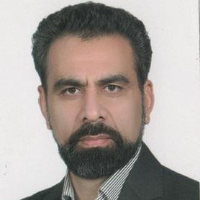Frames of Time: Types of Embodying Narrative Time in Qahvehkhaneh Painting
Author(s):
Article Type:
Research/Original Article (دارای رتبه معتبر)
Abstract:
The close affinity and link between painting and literature characterizes Persian painting. However, towards the end of the Qajar era, the use of painting for illustration "in" literary or historical books decreased for various reasons. Meanwhile, the Qahvehkhaneh painting tradition took up this age-old mode, placing the illustration of verbal narratives at the center of attention. Qahvehkhaneh painters employed various modes of illustrative narration. The extent and combination of these modes appears to have reached a novel stage in Iranian painting history. The present article investigates the structural link between text and image in the Qahvehkhaneh painting. For this aim, drawing upon Wichkoff's taxonomy in identifying types of visual narrative and Lessing's crucial concepts in distinguishing painting from literature, it examines the following questions: (1) "What" types of visual narration are there in the works of this school and (2) “How” the narrative time crystallizes in Qahvehkhaneh painting?The study is conducted using a descriptive- comparative method. According to the findings, many of this school's paintings have been restricted to the pregnant moment. These paintings only illustrate the culmination of the verbal narrative. Thus, in an instance of time imagination, the audience could imagine the events before or after this frozen moment. Therefore, although in this method that Wichkoff describes as Isolated Method, time is restricted and limited in the visual narrative, in the final analysis, these illustrations have some hidden timing. It means they put forward the time sequence subjectively rather than objectively. Utilizing this method constitutes a strategic compromise between the essentially spatial medium of painting and the time-bound medium of literature.However, in an intriguing initiative in some works in Qahvehkhaneh painting, these distinct illustrations come together in one single frame, displaying the whole fictional narrative, i.e., its numerous moments consecutively. This method is unprecedented in the Persian painting tradition. Among Qahvehkhaneh painters, Mohammad Modabber, a forerunner of this school, created most of his works in this style. This method came to be embraced and employed by the next generation of Qahvehkhaneh painters in numerous forms. In the works of painters such as Fathollah Ghoullar Aghasi, Hossein Hamedani, Hasan Esmaeilzadeh, Ahmad Khalili, Mostafa Hamidi, Mohammad Hamidi, Abbas Boloukifar, Mohammad Farahani, and Ali Akbar Larni, these parts were arranged more diversely. The potential of this mode of visual narrative is in its compatibility with Western aesthetic principles. In these works, the pregnant moment could be drawn by placing the subject in perspective. As seen in the works of Modabber, every part of the numerous illustrations in a painting frame has its unique perspective. The teachings and academic taste of some of the teachers of Mohammad Modabber, who were influenced by Kamal-Ol-Molk's teachings, appear to have been instrumental in adopting and expanding this visual narrative method. It is true that foreign aesthetics and techniques gradually increase in the works of Qahvehkhaneh painters. However, the Qahvehkhaneh painting renders these techniques its own by consecutively arranging distinct illustrations of pregnant moments, adapting them to polish its unique aesthetics.In addition to the isolated method, the Qahvehkhaneh painters drew upon the continuous method in displaying the numerous illustrations of a narrative. Notably, shunning the sequence of distinct illustrations, Hossein Ghoullar Aghasi used this method for a detailed articulation of the narrative. This method illustrates the personages in a spatial continuum without changing the stage in the succession of events in a time sequence. The canvas is full of sequences and time lapses. Different times and places assume a narrative continuity and singularity on the canvas. Even though this method was present in religious iconography since the age of the Safavid and the Zand dynasties in Persian visual tradition, the Qahvehkhaneh painter revived this tradition, notably in depicting the battle of Karbala. Today the works of this school are characterized by this tendency. Besides Hossein Ghoullar Aghasi, many Qahvehkhaneh painters, such as Mohammad Modabber, Hasan Esmaeilzadeh, Abbas Boloukifar, and Mohammad Farahani, employed this method of visual narrative in their early works.The close link between the Qahvehkhaneh painting and the religious, literary, and popular narratives seems to have expanded and deepened novel methods of visual narratives. The works of this school each represent the height of affinity between verbal and visual narratives, where time penetrates the space and the canvas, taking on a visible manifestation. This manifestation can be regarded as the last and the brightest link between text and image in the Iranian painting’s tradition.
Keywords:
Language:
Persian
Published:
Negareh journal, Volume:19 Issue: 69, 2024
Pages:
111 to 125
magiran.com/p2713367
دانلود و مطالعه متن این مقاله با یکی از روشهای زیر امکان پذیر است:
اشتراک شخصی
با عضویت و پرداخت آنلاین حق اشتراک یکساله به مبلغ 1,390,000ريال میتوانید 70 عنوان مطلب دانلود کنید!
اشتراک سازمانی
به کتابخانه دانشگاه یا محل کار خود پیشنهاد کنید تا اشتراک سازمانی این پایگاه را برای دسترسی نامحدود همه کاربران به متن مطالب تهیه نمایند!
توجه!
- حق عضویت دریافتی صرف حمایت از نشریات عضو و نگهداری، تکمیل و توسعه مگیران میشود.
- پرداخت حق اشتراک و دانلود مقالات اجازه بازنشر آن در سایر رسانههای چاپی و دیجیتال را به کاربر نمیدهد.
In order to view content subscription is required
Personal subscription
Subscribe magiran.com for 70 € euros via PayPal and download 70 articles during a year.
Organization subscription
Please contact us to subscribe your university or library for unlimited access!



